An Improved Lax-Wendroff Scheme for Two-Dimensional Transient Thermal Simulation
Abstract
:1. Introduction
2. Methods
2.1. LHOFD Scheme
2.2. IHOFD Scheme
2.3. Difference Operators and Coefficient Formulas
2.3.1. HOCFD Operator and Coefficient Formula
- (1)
- , ,
- (2)
- , , ,
- (3)
2.3.2. HONFD Operator and Coefficient Formulas
3. Schemes Analysis
3.1. Accuracy Analysis
3.2. Stability Formulas and Analysis
4. Integration Procedure
4.1. Initial Condition and Boundary Conditions
4.2. Boundary Process for the High-Order FD Schemes
5. Results of Numerical Experimentation
5.1. Stability Formula Analysis of the Different Schemes
5.2. Comparison of the Different-Order LHOFD Schemes
5.3. Comparison of the Different Schemes
5.4. Comparison of the IHOFD Scheme under Asymmetric Boundary Conditions
6. Conclusions
- (1)
- We present an LHOFD algorithm to numerically solve the 2D transient HCEs, and develop an IHOFD algorithm using stability analysis and a stencil combination optimization strategy to improve the stability of the LHOFD algorithm. The proposed algorithms are valid under both symmetric and asymmetric boundary conditions. The stability factor of the LHOFD algorithm is slightly higher than that of the conventional algorithm. The stability factor of the IHOFD algorithm is twice the conventional algorithm, and the maximum absolute error of the thermal simulation is within 0.015 (°C).
- (2)
- Based on the standard Taylor expansion and the Lagrange interpolation formula, we derive the formulas of the general high-order central FD (HOCFD) coefficients and the truncation error coefficient as well as the high-order non-central FD (HONFD) coefficients and the truncation error coefficient of fourth-order spatial derivative in a concise and clear way, and provide another way to calculate high-order FD coefficients and its truncation error coefficient.
- (3)
- A unified analytical formula for the general HOCFD and HONFD coefficients that can calculate the spatial derivative of any integer order is also derived, which can be applied to the numerical calculation of the HOFD methods in a regular mesh domain for different types of integer-order partial differential equations, including heat conduction equation.
- (4)
- We propose a new strategy of combination with the HOCFD and HONFD approximations under the same high-order accuracy, namely that of using the internal computational domain to calculate the mixed derivatives of the boundary domains, which has higher accuracy, no additional computational cost, and is easy to implement.
Author Contributions
Funding
Institutional Review Board Statement
Informed Consent Statement
Data Availability Statement
Conflicts of Interest
Nomenclature
| Thermal conductivity coefficient | Density | ||
| Specific heat capacity | Thermal conductivity | ||
| Time step | Temperature field | ||
| Number of time step iterations | HONFD operator coefficient | ||
| Operator of derivative | Length of the HONFD operator | ||
| Order number of the operator | Stencil vector element of the HONFD operator | ||
| Weighting coefficient | Arbitrary order of the space derivative | ||
| Numerical simulation result | Length of the shortest operator | ||
| Exact solution | Stability factor | ||
| Mesh interval along the x coordinate | Parameters of stability factor | ||
| Mesh interval along the y coordinate | Total point numbers | ||
| Operator coefficient of the second-order spatial derivative | Number of meshes along the x coordinate | ||
| Operator coefficient of the fourth-order spatial derivative | Number of meshes along the y coordinate | ||
| Coefficients matrix of the fourth-order spatial mixed derivative | Mesh interval () |
Appendix A. The Formula for the HOCFD Coefficients of the Fourth-Order Spatial Derivative
- (1)
- , ,
- (2)
- , , ,
- (3)
Appendix B. The Formula for the HONFD Coefficients of the Fourth-Order Spatial Derivative
Appendix C. Stability Formula of the LHOFD Scheme
References
- Ali, M.E.; Loskor, W.Z.; Taher, S.; Bilkis, F. Solution of a One-Dimension Heat Equation Using Higher-Order Finite Difference Methods and Their Stability. J. Appl. Math. Phys. 2022, 10, 877–886. [Google Scholar] [CrossRef]
- Hassan, H.; Shafey, N.Y.A.; Uddin, Z.; Hawwash, A.A. 3D investigation on the impact of chips positions and number on their cooling inside cavity. J. Mech. Sci. Technol. 2021, 35, 5233–5244. [Google Scholar] [CrossRef]
- Xiong, Z.; Wang, X.; He, M.; Benabou, L.; Feng, Z. Investigation on thermal conductivity of silver-based porous materials by finite difference method. Mater. Today Commun. 2022, 33, 104897. [Google Scholar] [CrossRef]
- Zhang, H.; Geng, J.; Zhu, S.; Zhao, Y.; Ji, S.; Guo, X.; Tong, Z.; Li, D. An effective method for large-scale temperature simulation in SLM based on the finite difference. Numer. Heat Transfer Part A Appl. 2022, 83, 503–521. [Google Scholar] [CrossRef]
- Lax, P.D.; Wendroff, B. Difference schemes for hyperbolic equations with high order of accuracy. Commun. Pure Appl. Math. 1964, 17, 381–398. [Google Scholar] [CrossRef]
- Blanch, J.O.; Robertsson, J.O.A. A modified Lax-Wendroff correction for wave propagation in media described by Zener elements. Geophys. J. Int. 1997, 131, 381–386. [Google Scholar] [CrossRef]
- Chen, J.-B. A stability formula for Lax-Wendroff methods with fourth-order in time and general-order in space for the scalar wave equation. Geophysics 2011, 76, T37–T42. [Google Scholar] [CrossRef]
- Amundsen, L.; Pedersen, Ø. Time step n-tupling for wave equations. Geophysics 2017, 82, T249–T254. [Google Scholar] [CrossRef]
- Liu, H.; Zhang, H. Reducing computation cost by Lax-Wendroff methods with fourth-order temporal accuracy. Geophysics 2019, 84, T109–T119. [Google Scholar] [CrossRef]
- Ren, Z.; Bao, Q.; Gu, B. Time-dispersion correction for arbitrary even-order Lax-Wendroff methods and the application on full-waveform inversion. Geophysics 2021, 86, T361–T375. [Google Scholar] [CrossRef]
- Tan, S.; Huang, L. An efficient finite-difference method with high-order accuracy in both time and space domains for modelling scalar-wave propagation. Geophys. J. Int. 2014, 197, 1250–1267. [Google Scholar] [CrossRef]
- Wang, E.; Liu, Y.; Sen, M.K. Effective finite-difference modelling methods with 2-D acoustic wave equation using a combination of cross and rhombus stencils. Geophys. J. Int. 2016, 206, 1933–1958. [Google Scholar] [CrossRef]
- Chen, G.; Wang, Y.; Wang, Z.; Zhang, S. Dispersion-relationship-preserving seismic modelling using the cross-rhombus stencil with the finite-difference coefficients solved by an over-determined linear system. Geophys. Prospect. 2020, 68, 1771–1792. [Google Scholar] [CrossRef]
- Titarev, V.A.; Toro, E.F. ADER: Arbitrary High Order Godunov Approach. J. Sci. Comput. 2002, 17, 609–618. [Google Scholar] [CrossRef]
- Toro, E.; Titarev, V. ADER schemes for scalar non-linear hyperbolic conservation laws with source terms in three-space dimensions. J. Comput. Phys. 2005, 202, 196–215. [Google Scholar] [CrossRef]
- Toro, E.F.; Titarev, V.A. TVD Fluxes for the High-Order ADER Schemes. J. Sci. Comput. 2005, 24, 285–309. [Google Scholar] [CrossRef]
- Arar, N.; Kaki, L.A.; Ben Makhlouf, A. Highly Efficacious Sixth-Order Compact Approach with Nonclassical Boundary Specifications for the Heat Equation. Math. Probl. Eng. 2022, 2022, 1–13. [Google Scholar] [CrossRef]
- Yosaf, A.; Rehman, S.U.; Ahmad, F.; Ullah, M.Z.; Alshomrani, A.S. Eighth-Order Compact Finite Difference Scheme for 1D Heat Conduction Equation. Adv. Numer. Anal. 2016, 2016, 1–12. [Google Scholar] [CrossRef]
- Hajipour, M.; Jajarmi, A.; Malek, A.; Baleanu, D. Positivity-preserving sixth-order implicit finite difference weighted essentially non-oscillatory scheme for the nonlinear heat equation. Appl. Math. Comput. 2018, 325, 146–158. [Google Scholar] [CrossRef]
- Ecer, A.; Gopalaswamy, N.; Akay, H.U.; Chien, Y.P. Digital Filtering Techniques for Parallel Computation of Explicit Schemes. Int. J. Comput. Fluid Dyn. 2000, 13, 211–222. [Google Scholar] [CrossRef]
- Sarris, C.D. Extending the Stability Limit of the FDTD Method With Spatial Filtering. IEEE Microw. Wirel. Compon. Lett. 2011, 21, 176–178. [Google Scholar] [CrossRef]
- Gao, Y.; Zhang, J.; Yao, Z. Extending the stability limit of explicit scheme with spatial filtering for solving wave equations. J. Comput. Phys. 2019, 397, 108853. [Google Scholar] [CrossRef]
- Gaffar, M.; Jiao, D. Alternative Method for Making Explicit FDTD Unconditionally Stable. IEEE Trans. Microw. Theory Tech. 2015, 63, 4215–4224. [Google Scholar] [CrossRef]
- Li, X.; Sarris, C.D.; Triverio, P. Overcoming the FDTD stability limit via model order reduction and eigenvalue perturbation. In Proceedings of the 2014 IEEE MTT-S International Microwave Symposium (IMS2014), Tampa, FL, USA, 1–6 June 2014; pp. 1–3. [Google Scholar]
- Gao, Y.; Zhang, J.; Yao, Z. Removing the stability limit of the explicit finite-difference scheme with eigenvalue perturbation. Geophysics 2018, 83, A93–A98. [Google Scholar] [CrossRef]
- Pei, Y.; Liu, J.; Li, W. A general high-order finite difference scheme for two-dimensional transient thermal simulation. Numer. Heat Transf. B Fundam. 2023; Unpublished Manuscript. [Google Scholar]
- Jo, C.; Shin, C.; Suh, J.H. An optimal 9-point, finite-difference, frequency-space, 2-D scalar wave extrapolator. Geophysics 1996, 61, 529–537. [Google Scholar] [CrossRef]
- Fornberg, B. Classroom Note:Calculation of Weights in Finite Difference Formulas. SIAM Rev. 1998, 40, 685–691. [Google Scholar] [CrossRef]
- Liu, Y.; Sen, M.K. A new time–space domain high-order finite-difference method for the acoustic wave equation. J. Comput. Phys. 2009, 228, 8779–8806. [Google Scholar] [CrossRef]
- Hicks, J.S.; Wei, J. Numerical Solution of Parabolic Partial Differential Equations With Two-Point Boundary Conditions by Use of the Method of Lines. J. ACM 1967, 14, 549–562. [Google Scholar] [CrossRef]
- Fukuchi, T. Finite difference method and algebraic polynomial interpolation for numerically solving Poisson’s equation over arbitrary domains. AIP Adv. 2014, 4, 060701. [Google Scholar] [CrossRef]
- Dai, W. A new accurate finite difference scheme for Neumann (insulated) boundary condition of heat conduction. Int. J. Therm. Sci. 2010, 49, 571–579. [Google Scholar] [CrossRef]
- Li, S.; Sun, C. An improved 25-point finite-difference scheme for frequency-domain elastic wave modelling. Geophys. Prospect. 2022, 70, 702–724. [Google Scholar] [CrossRef]
- Press, W.H.; Teukolsky, S.A.; Vetterling, W.T.; Flannery, B.P. Numerical Recipes in C: The Art of Scientific Computing, 2nd ed.; Cambridge University Press: Cambridge, UK, 1992. [Google Scholar]
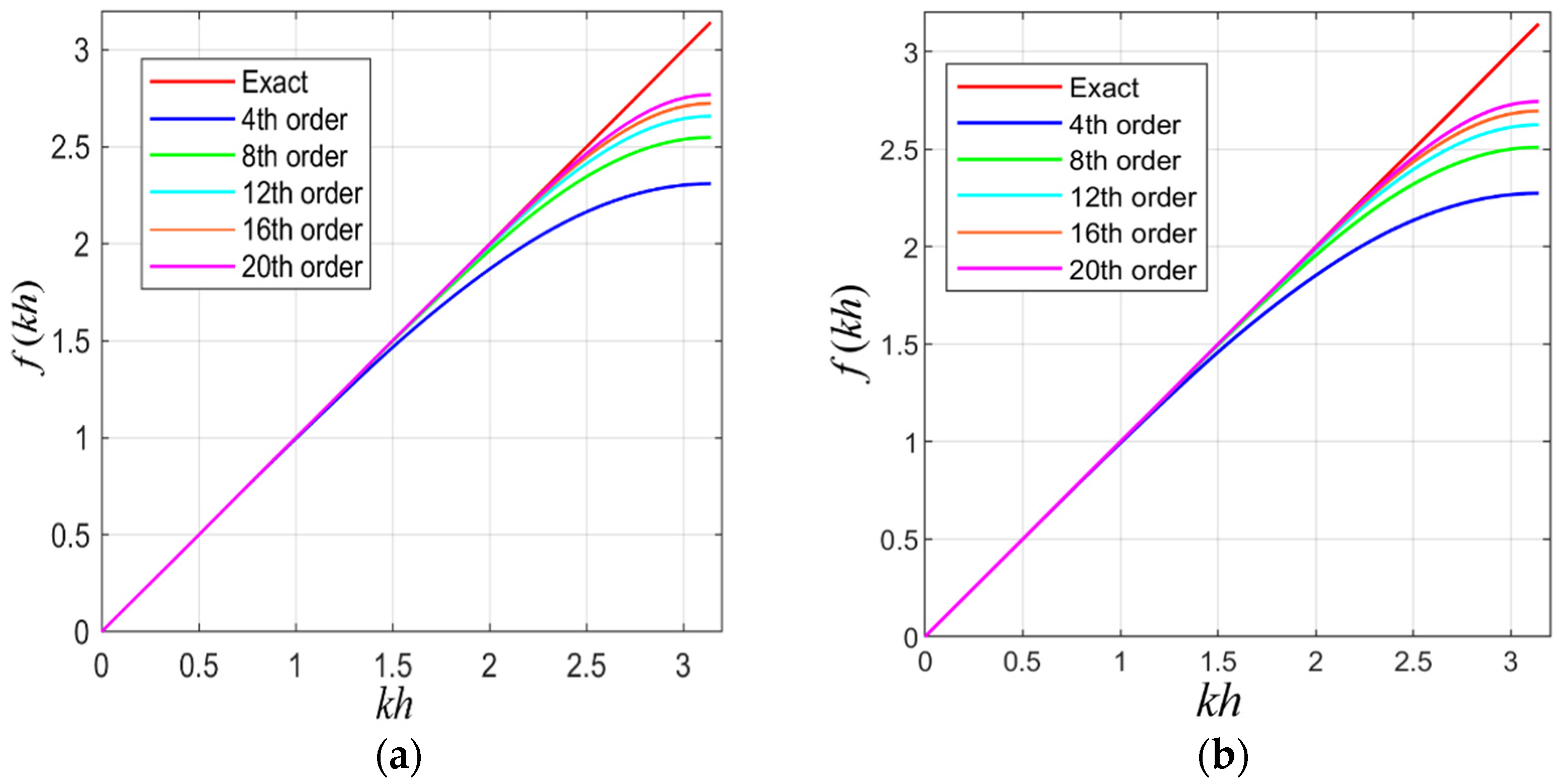
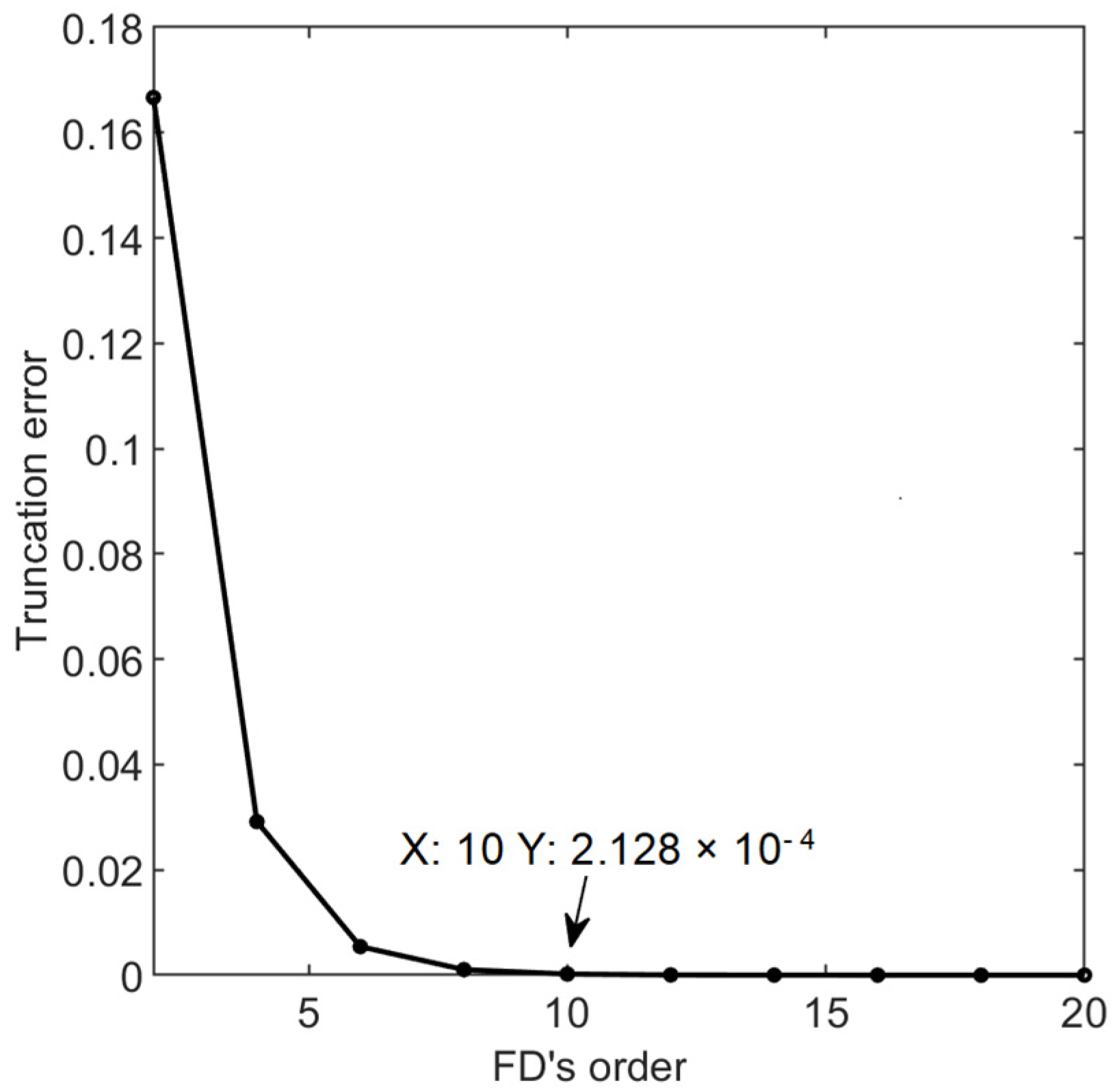
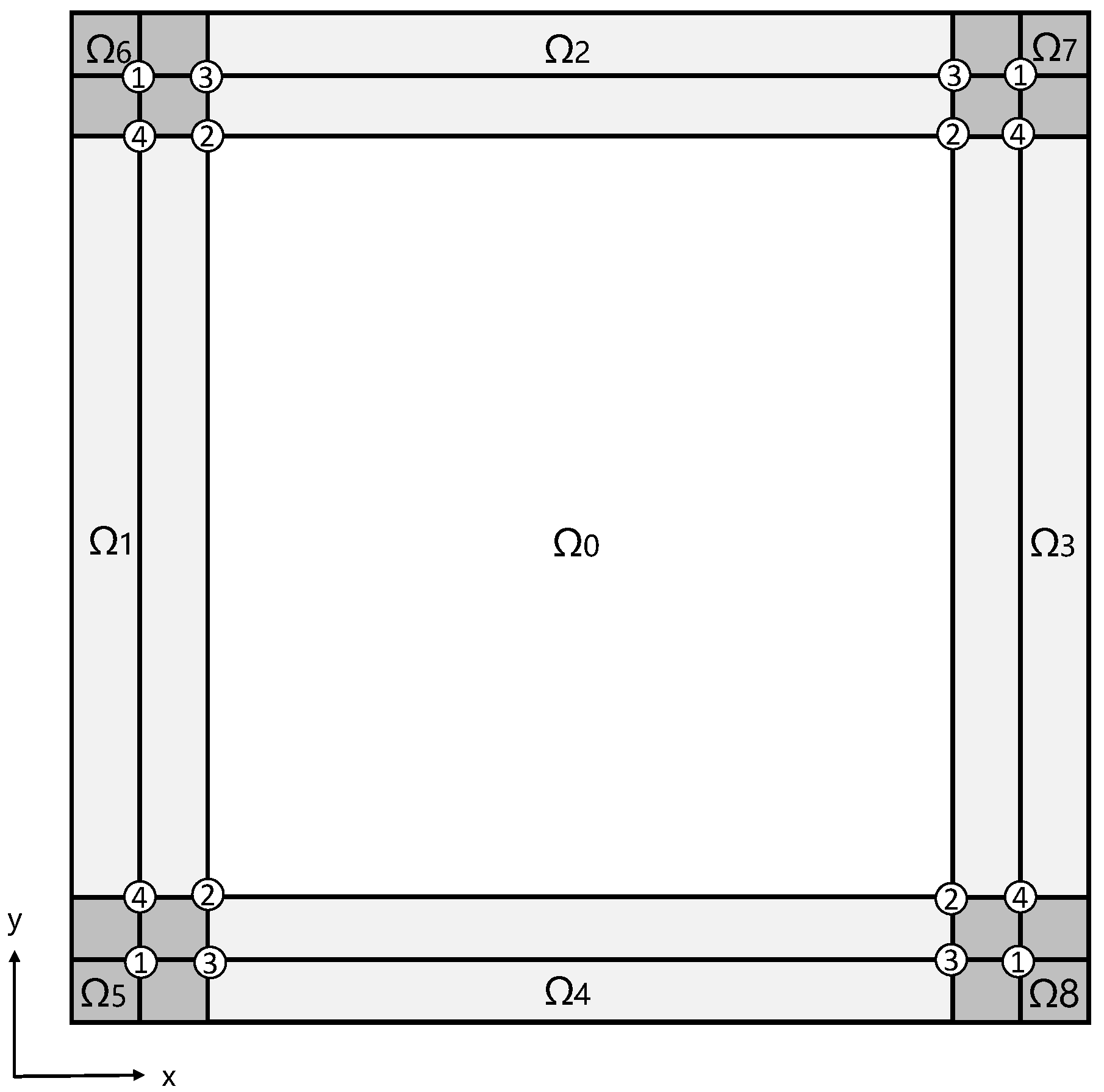
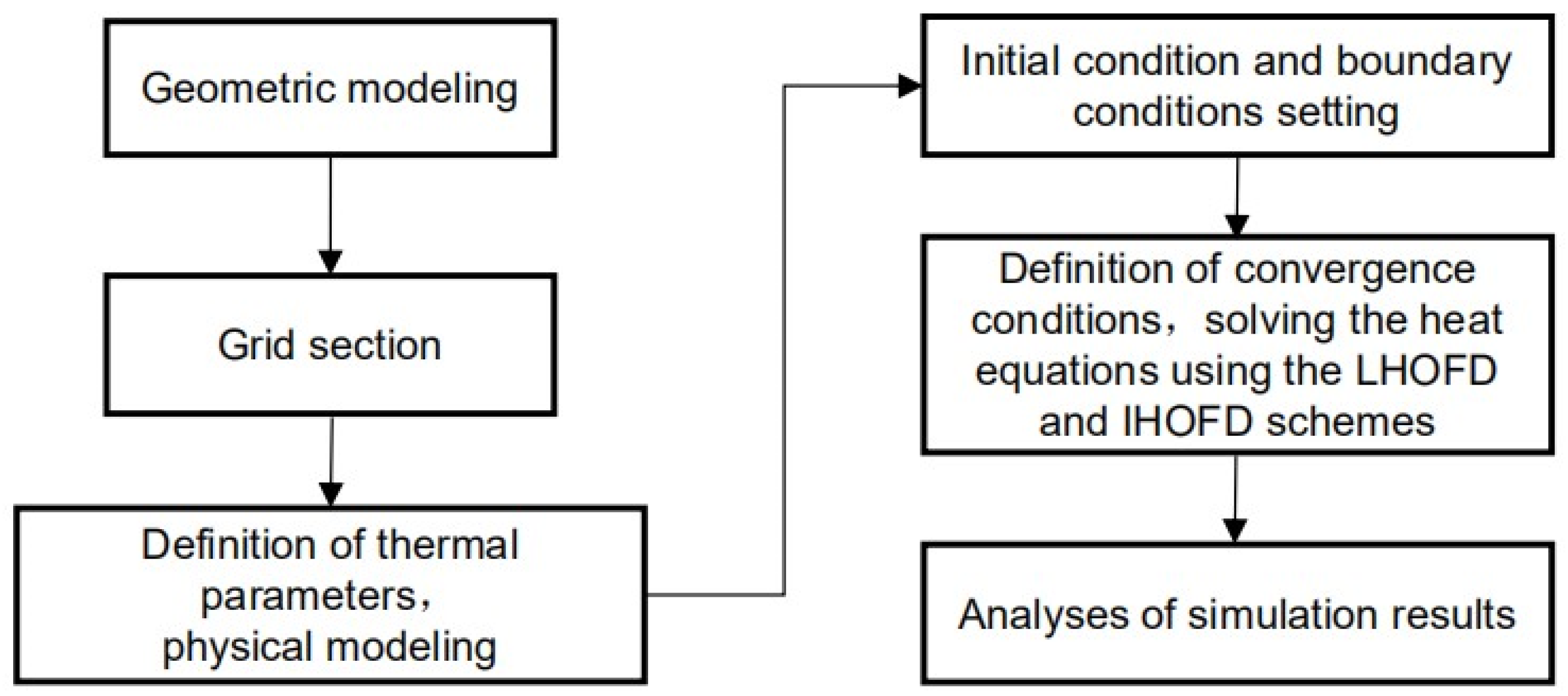
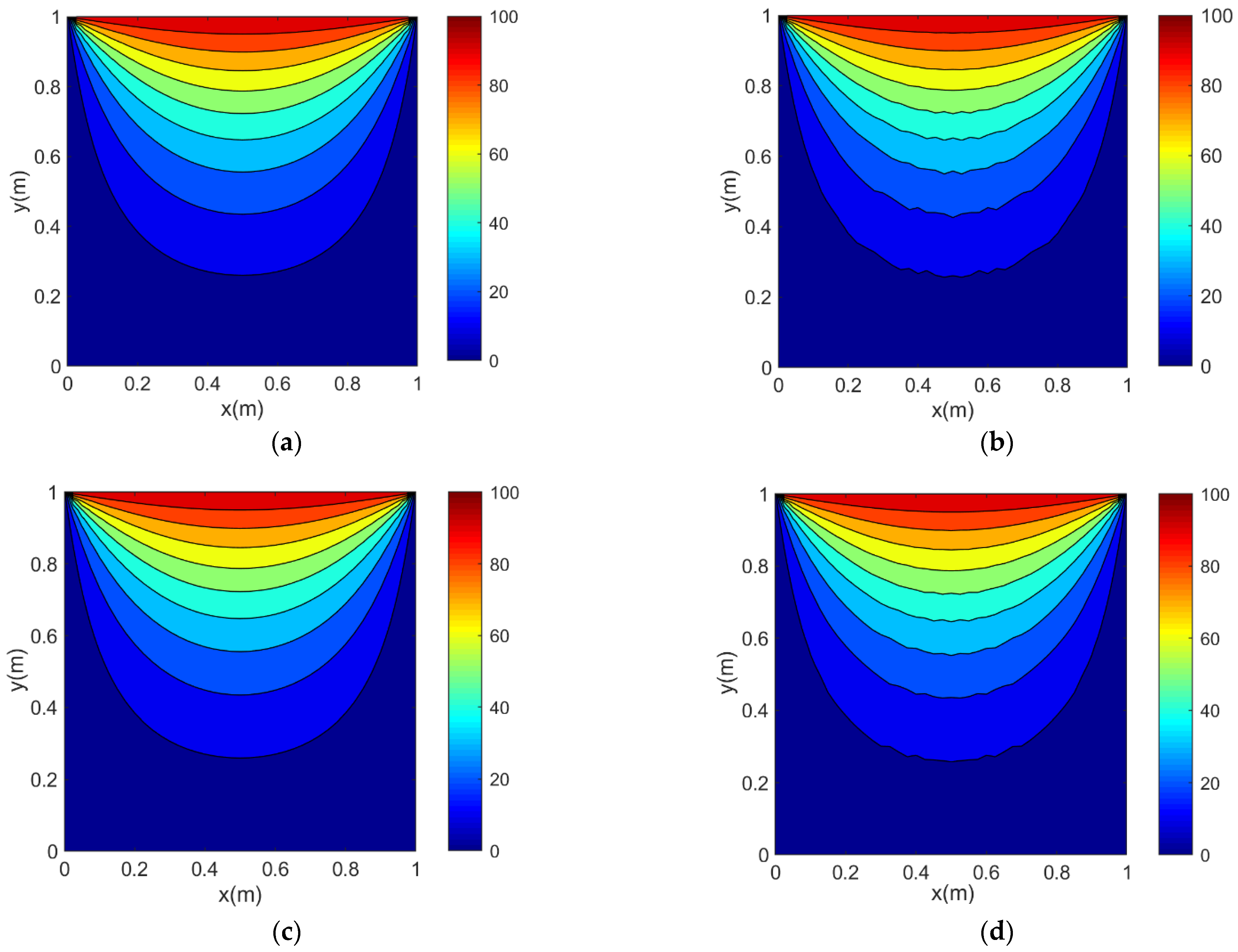
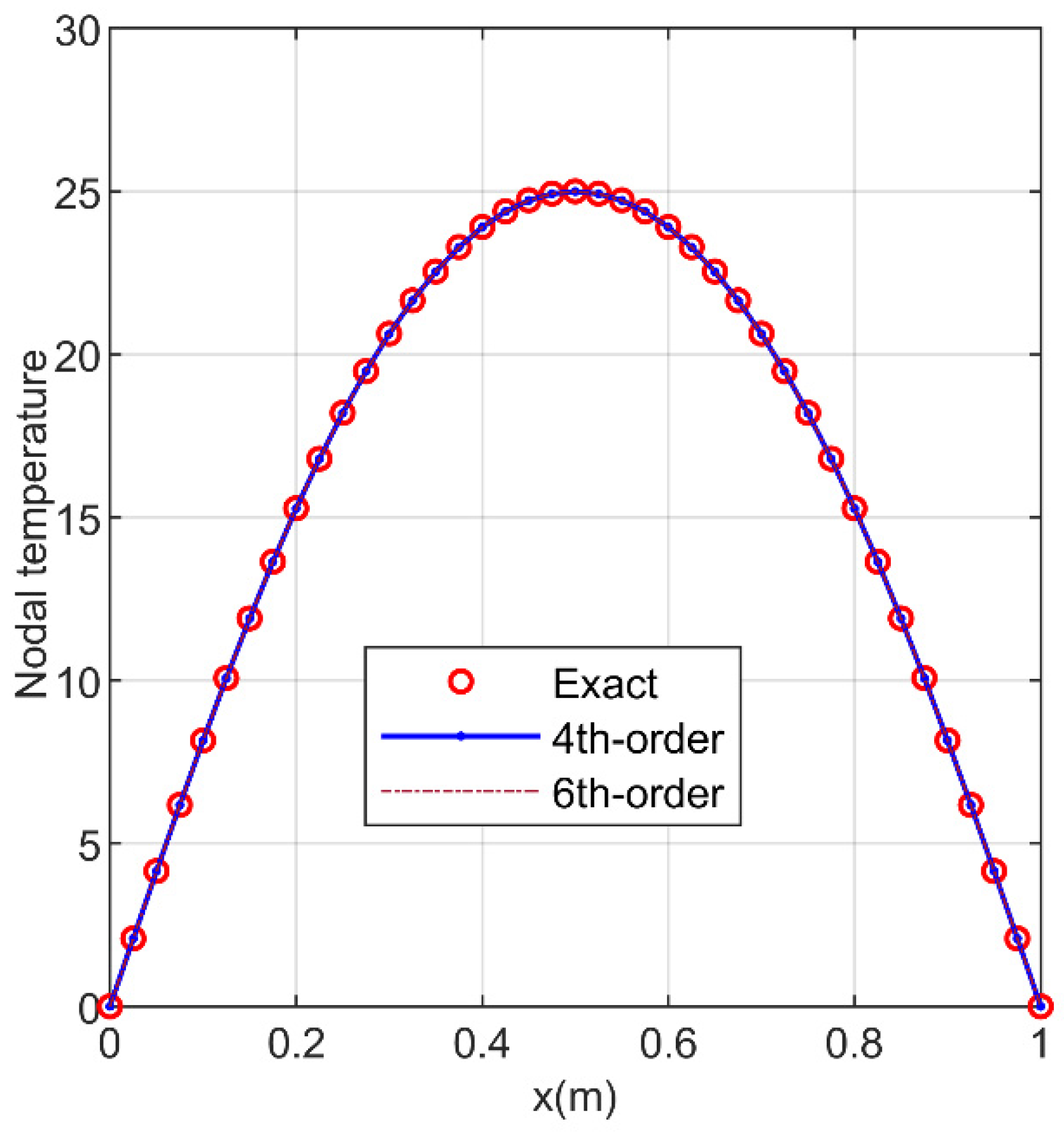
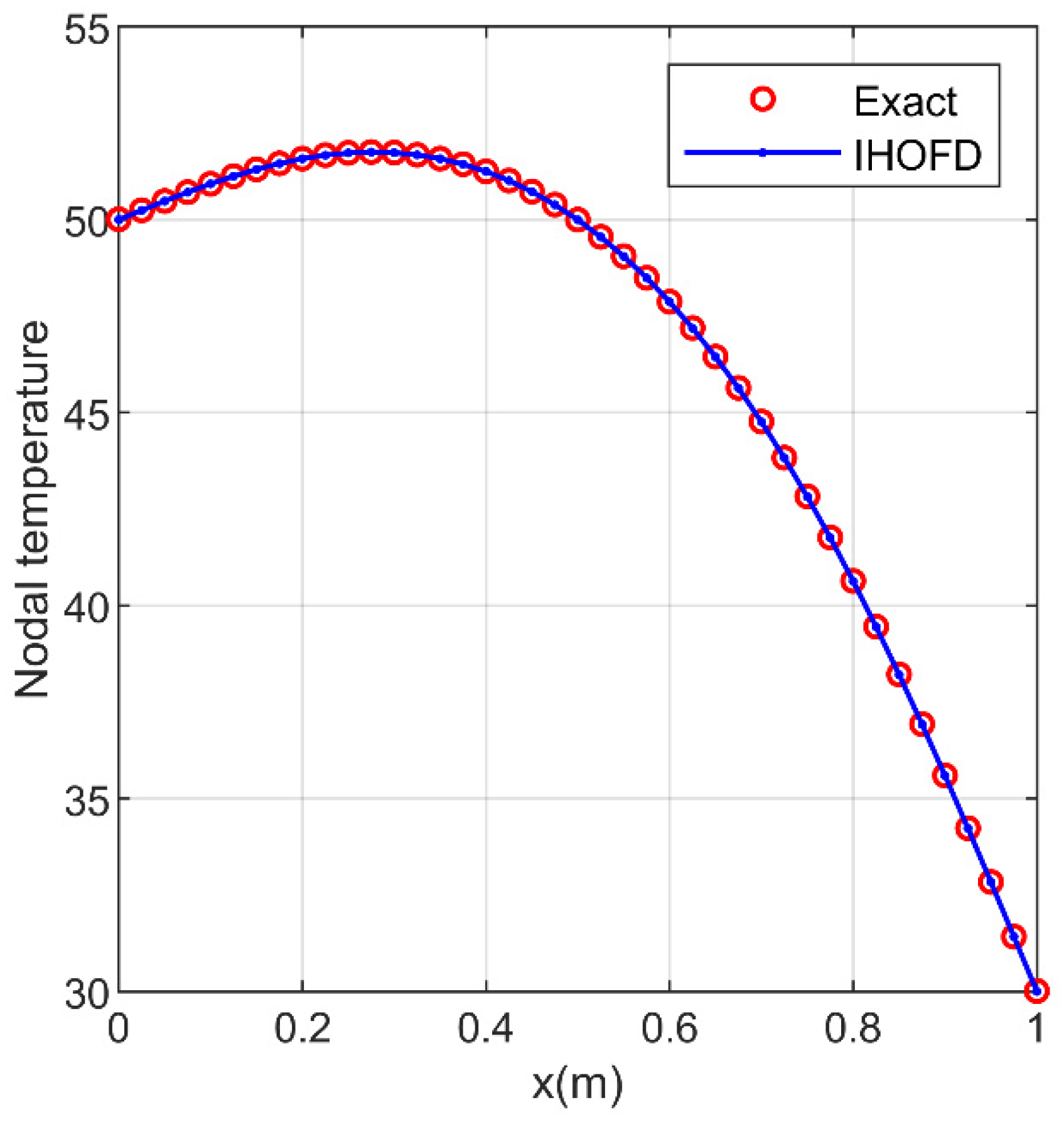

| Num. | HONFD Stencils | HONFD Coefficients | ||||||||||||||||
|---|---|---|---|---|---|---|---|---|---|---|---|---|---|---|---|---|---|---|
| q1 | q2 | q3 | q4 | q5 | q6 | q7 | q8 | q9 | p1 | p2 | p3 | p4 | p5 | p6 | p7 | p8 | p9 | |
| 1 | −1 | 0 | 1 | 2 | 3 | 4 | 5 | 6 | 7 | 967/240 | −229/10 | 3439/60 | −2509/30 | 631/8 | −1489/30 | 1219/60 | −49/10 | 127/240 |
| 2 | −2 | −1 | 0 | 1 | 2 | 3 | 4 | 5 | 6 | 127/240 | −11/15 | −77/20 | 193/15 | −407/24 | 61/5 | −311/60 | 19/15 | −11/80 |
| 3 | −3 | −2 | −1 | 0 | 1 | 2 | 3 | 4 | 5 | −11/80 | 53/30 | −341/60 | 77/10 | −107/24 | 11/30 | 13/20 | −7/30 | 7/240 |
| 4 | −7 | −6 | −5 | −4 | −3 | −2 | −1 | 0 | 1 | 127/240 | −49/10 | 1219/60 | −1489/30 | 631/8 | −2509/30 | 3439/60 | −229/10 | 967/240 |
| 5 | −4 | −3 | −2 | −1 | 0 | 1 | 2 | 3 | 4 | 7/240 | −2/5 | 169/60 | −122/15 | 91/8 | −122/15 | 169/60 | −2/5 | 7/240 |
| 2M Order | 2 | 4 | 6 | 8 | 10 | 12 | 14 | 16 | 18 | 20 |
|---|---|---|---|---|---|---|---|---|---|---|
| 0.289 | 0.716 | 1.043 | 1.279 | 1.458 | 1.599 | 1.712 | 1.806 | 1.885 | 1.951 | |
| 0.135 | 0.452 | 0.741 | 0.974 | 1.159 | 1.307 | 1.429 | 1.533 | 1.618 | 1.693 |
| 2M Order | 2 | 4 | 6 | 8 | 10 | 12 | 14 | 16 | 18 | 20 |
|---|---|---|---|---|---|---|---|---|---|---|
| 0.289 | 0.682 | 0.990 | 1.219 | 1.398 | 1.539 | 1.653 | 1.747 | 1.828 | 1.898 | |
| 0.135 | 0.427 | 0.701 | 0.924 | 1.106 | 1.254 | 1.376 | 1.480 | 1.568 | 1.646 |
| 2M Order | 4 | 6 | 8 | 10 | 12 | 14 | 16 | 18 | 20 |
|---|---|---|---|---|---|---|---|---|---|
| GHOFD’s stability factor | 1.875 | 1.654 | 1.538 | 1.465 | 1.414 | 1.376 | 1.346 | 1.323 | 1.303 |
| LHOFD’s stability factor | 1.938 | 1.713 | 1.588 | 1.508 | 1.451 | 1.409 | 1.376 | 1.350 | 1.328 |
| CHOFD’s stability factor | 3.750 | 3.309 | 3.076 | 2.930 | 2.828 | 2.752 | 2.693 | 2.645 | 2.606 |
| Num. | HONFD Stencils | HONFD Coefficients | ||||||||||||
|---|---|---|---|---|---|---|---|---|---|---|---|---|---|---|
| q1 | q2 | q3 | q4 | q5 | q6 | q7 | p1 | p2 | p3 | p4 | p5 | p6 | p7 | |
| 1 | −1 | 0 | 1 | 2 | 3 | 4 | 5 | 137/180 | −49/60 | −17/12 | 47/18 | −19/12 | 31/60 | −13/180 |
| 2 | −2 | −1 | 0 | 1 | 2 | 3 | 4 | −13/180 | 19/15 | −7/3 | 10/9 | 1/12 | −1/15 | 1/90 |
| 3 | −5 | −4 | −3 | −2 | −1 | 0 | 1 | −13/180 | 31/60 | −19/12 | 47/18 | −17/12 | −49/60 | 137/180 |
| 4 | −4 | −3 | −2 | −1 | 0 | 1 | 2 | 1/90 | −1/15 | 1/12 | 10/9 | −7/3 | 19/15 | −13/180 |
| 5 | −3 | −2 | −1 | 0 | 1 | 2 | 3 | 1/90 | −3/20 | 3/2 | −49/18 | 3/2 | −3/20 | 1/90 |
| Algorithms | 4th-Order, 1.4∆t1 | 4th-Order, 2∆t1 | 6th-Order, 1.6∆t2 | 6th-Order, 2∆t2 |
|---|---|---|---|---|
| RE × 10−4 | 4.240 | 6.063 | 4.275 | 5.348 |
| MAE (°C) × 10−2 | 0.987 | 1.411 | 0.996 | 1.245 |
Disclaimer/Publisher’s Note: The statements, opinions and data contained in all publications are solely those of the individual author(s) and contributor(s) and not of MDPI and/or the editor(s). MDPI and/or the editor(s) disclaim responsibility for any injury to people or property resulting from any ideas, methods, instructions or products referred to in the content. |
© 2023 by the authors. Licensee MDPI, Basel, Switzerland. This article is an open access article distributed under the terms and conditions of the Creative Commons Attribution (CC BY) license (https://creativecommons.org/licenses/by/4.0/).
Share and Cite
Pei, Y.; Jian, H.; Li, W. An Improved Lax-Wendroff Scheme for Two-Dimensional Transient Thermal Simulation. Appl. Sci. 2023, 13, 11713. https://doi.org/10.3390/app132111713
Pei Y, Jian H, Li W. An Improved Lax-Wendroff Scheme for Two-Dimensional Transient Thermal Simulation. Applied Sciences. 2023; 13(21):11713. https://doi.org/10.3390/app132111713
Chicago/Turabian StylePei, Yanrong, Haifang Jian, and Wenchang Li. 2023. "An Improved Lax-Wendroff Scheme for Two-Dimensional Transient Thermal Simulation" Applied Sciences 13, no. 21: 11713. https://doi.org/10.3390/app132111713
APA StylePei, Y., Jian, H., & Li, W. (2023). An Improved Lax-Wendroff Scheme for Two-Dimensional Transient Thermal Simulation. Applied Sciences, 13(21), 11713. https://doi.org/10.3390/app132111713






